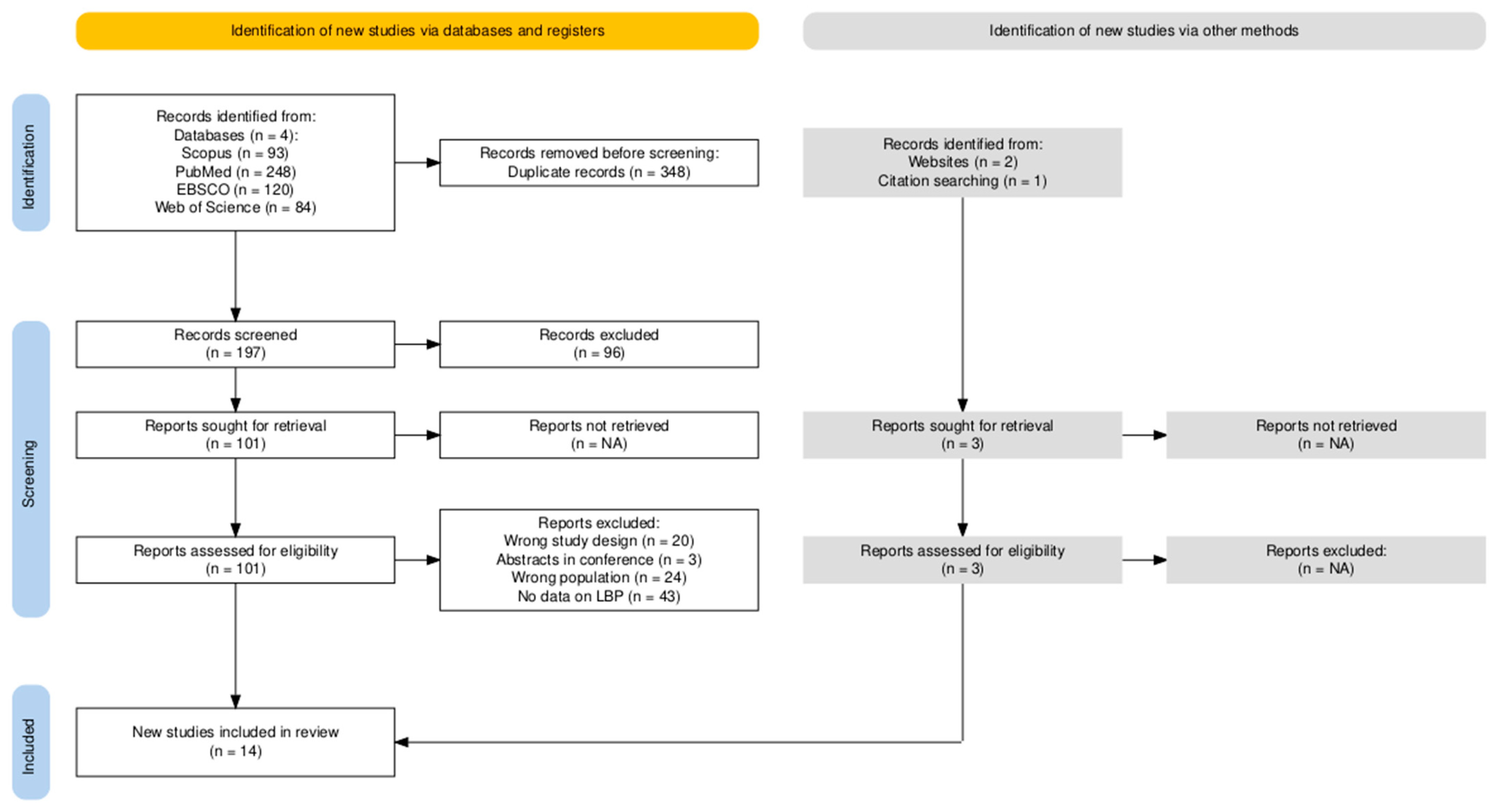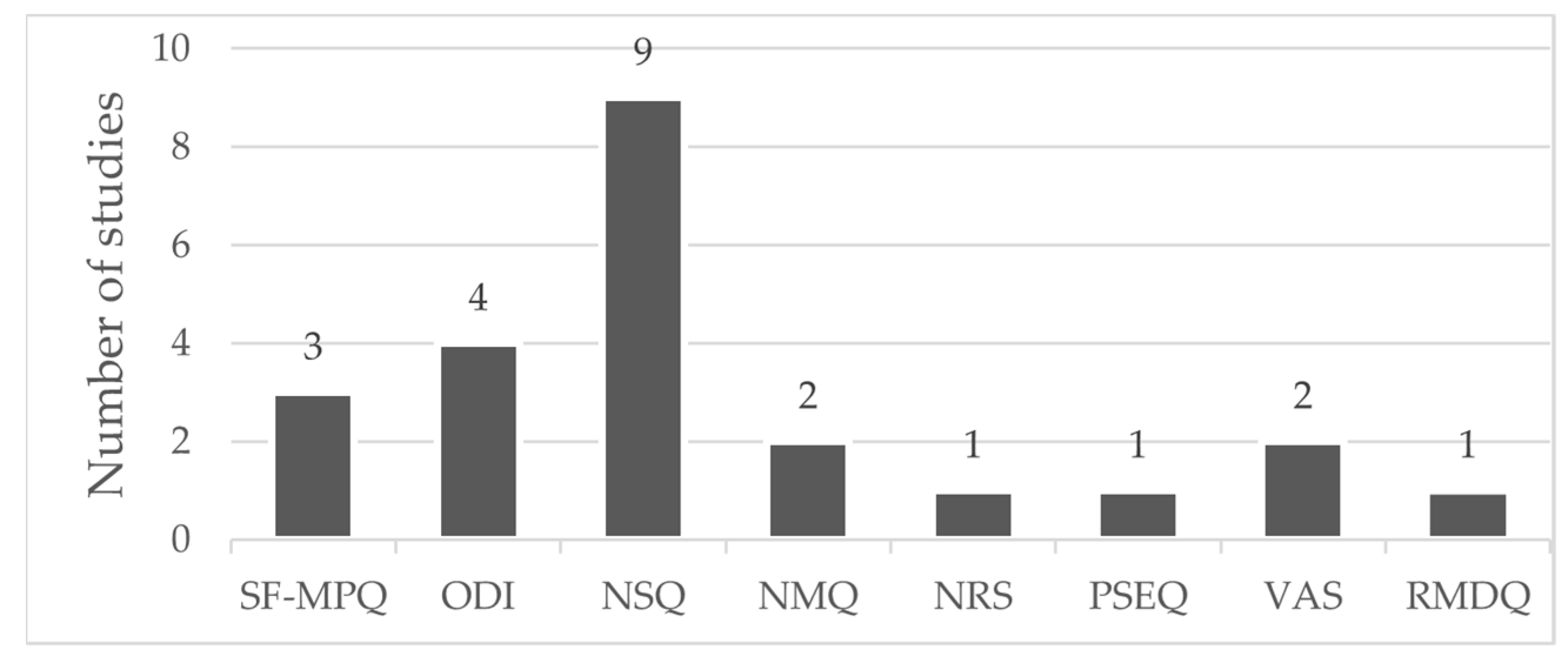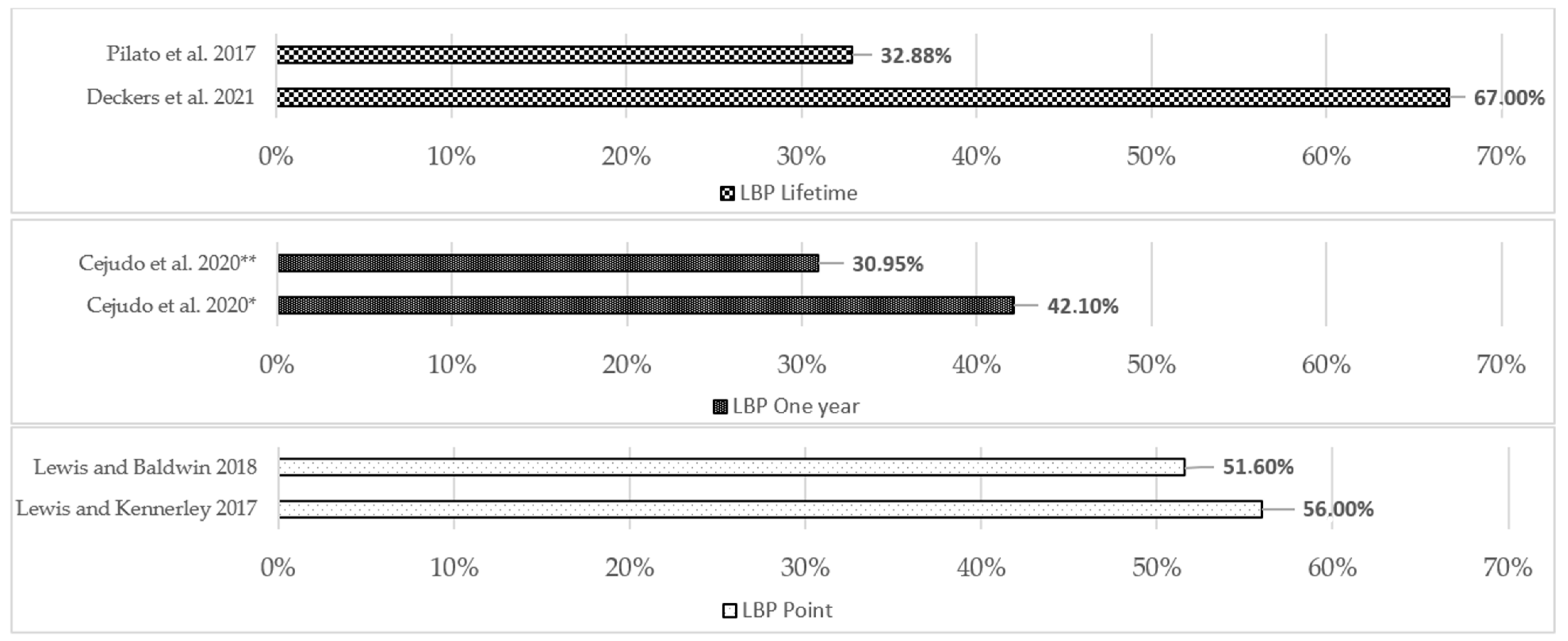Prevalence of Lower Back Pain and Risk Factors in Equestrians: A Systematic Review
Abstract
1. Introduction
2. Materials and Methods
2.1. Research Design
2.2. Types of Studies
2.3. Types of Participants and Exposure
2.4. Types of Outcome Measures
2.5. Information Sources and Search
2.6. Study Selection
2.7. Data Collection Process
2.8. Assessment of Methodological Quality and Risk Bias
2.9. Data Items and Analysis
3. Results
3.1. Study Selection
3.2. Characteristics of the Included Studies
3.3. Methodological Quality
3.4. Demographic and Anthropometric Characteristics of the Sample
3.5. Equestrian Sports
3.5.1. Discipline
3.5.2. Level of Sport
3.5.3. Sports Practice
3.5.4. Equestrian-Related Activities
3.6. Other Sporting Activities
3.7. Anatomic Location and Nature of Injury
3.8. Tools and Methods for Measurement of LBP
3.9. Lower Back Pain
3.10. Duration and Frequency of Symptoms
3.11. Consequences of Pain
3.11.1. Levels of Pain, Severity, and Levels of Disability
3.11.2. Time Loss
3.11.3. Pain Management Techniques
3.12. Risk Factors, Associations, and Contributing Factors for LBP
4. Discussion
- Study Quality: Conducting higher-quality studies is essential to provide more substantial evidence regarding which variables pose risk factors for LBP and which do not.
- Research Tools: There is a pressing need to develop standardized questionnaires that address key questions, enabling researchers to better understand the prevalence of LBP in EAs and the factors contributing to its existence.
5. Limitations
6. Conclusions
Supplementary Materials
Author Contributions
Funding
Data Availability Statement
Acknowledgments
Conflicts of Interest
References
- Hoy, D.; Bain, C.; Williams, G.; March, L.; Brooks, P.; Blyth, F.; Woolf, A.; Vos, T.; Buchbinder, R. A systematic review of the global prevalence of low back pain. Arthritis Rheum. 2021, 64, 2028–2037. [Google Scholar] [CrossRef]
- Trompeter, K.; Fett, D.; Platen, P. Prevalence of Back Pain in Sports: A Systematic Review of the Literature. Sports Med. 2017, 47, 1183–1207. [Google Scholar] [CrossRef]
- Huang, R.; Ning, J.; Chuter, V.H.; Taylor, J.B.; Christophe, D.; Meng, Z.; Jiang, L. Exercise alone and exercise combined with education both prevent episodes of low back pain and related absenteeism: Systematic review and network meta-analysis of randomised controlled trials [RCTs] aimed at preventing back pain. Br. J. Sports Med. 2020, 54, 766–770. [Google Scholar] [CrossRef] [PubMed]
- Heneweer, H.; Picavet, H.; Staes, F.; Kiers, H.; Vanhees, L. Physical fitness, rather than self-reported physical activities, is more strongly associated with low back pain: Evidence from a working population. Eur. Spine J. 2012, 21, 1265–1272. [Google Scholar] [CrossRef] [PubMed][Green Version]
- Keener, M.M.; Tumlin, K.I. Self-reported acute injury and chronic pain in American equestrian athletes. Comp. Exerc. Physiol. 2023, 1, 1–14. [Google Scholar] [CrossRef]
- Wilson, F.; Ardern, C.L.; Hartvigsen, J.; Dane, K.; Trompeter, K.; Trease, L.; Vinther, A.; Gissane, C.; McDonnell, S.J.; Carneiro, J.P.; et al. Prevalence and risk factors for back pain in sports: A systematic review with meta-analysis. Br. J. Sports Med. 2021, 55, 601–607. [Google Scholar] [CrossRef] [PubMed]
- Williams, J. Performance analysis in equestrian sport. Comp. Exerc. Physiol. 2013, 9, 67–77. [Google Scholar] [CrossRef]
- Pugh, T.J.; Bolin, D. Overuse Injuries in Equestrian Athletes. Curr. Sports Med. Rep. 2004, 3, 297–303. [Google Scholar] [CrossRef] [PubMed]
- Dumbell, L.C.; Rowe, L.; Douglas, J.L. Demographic profiling of British Olympic equestrian athletes in the twenty-first century. Sport Soc. 2018, 21, 1337–1350. [Google Scholar] [CrossRef]
- Haan, D. A Review of the Appropriateness of Existing Micro- and Meso-level Models of Athlete Development within Equestrian Sport. Int. J. Hum. Mov. Sports Sci. 2017, 5, 1–8. [Google Scholar] [CrossRef][Green Version]
- Hoy, D.; Brooks, P.; Blyth, F.; Buchbinder, R. The epidemiology of low back pain. Best Prat. Res. Clin. Rheumatol. 2010, 24, 769–781. [Google Scholar] [CrossRef] [PubMed]
- Lewis, V.; Douglas, J.L.; Edwards, T.; Dumbell, L. A preliminary study investigating functional movement screen test scores in female collegiate age horse-riders. Comp. Exerc. Physiol. 2019, 15, 105–112. [Google Scholar] [CrossRef]
- Page, M.J.; McKenzie, J.E.; Bossuyt, P.M.; Boutron, I.; Hoffmann, T.C.; Mulrow, C.D.; Shamseer, L.; Tetzlaff, J.M.; Akl, E.A.; Brennan, S.E.; et al. The PRISMA 2020 statement: An updated guideline for reporting systematic reviews. BMJ 2021, 372, n71. [Google Scholar] [CrossRef] [PubMed]
- Carlson, M.D.; Morrison, R.S. Study Design, Precision, and Validity in Observational Studies. J. Palliat. Med. 2009, 12, 77–82. [Google Scholar] [CrossRef]
- Drukker, M.; Weltens, I.; van Hooijdonk, C.; Vandenberk, E.; Bak, M. Development of a methodological quality criteria list for observational studies: The observational study quality evaluation. Front. Res. Metr. Anal. 2021, 6, 675071. [Google Scholar] [CrossRef]
- Munn, Z.; Moola, S.; Lisy, K.; Riitano, D.; Tufanaru, C. Chapter 5: Systematic reviews of prevalence and incidence. In JBI Manual for Evidence Synthesis; Aromataris, E., Munn, Z., Eds.; JBI: North Adelaide, Australia, 2020; pp. 177–217. [Google Scholar] [CrossRef]
- Corporation, Microsoft. Microsoft Excel (Version 2021). Available online: https://www.microsoft.com (accessed on 30 October 2024).
- Naing, L.; Nordin, R.; Rahman, H.; Naing, Y. Sample size calculation for prevalence studies using Scalex and ScalaR calculators. BMC Med. Res. Methodol. 2022, 22, 209. [Google Scholar] [CrossRef]
- Epitools Epidemiological Calculators. (Ausvet). Sergeant, ESG. Available online: https://epitools.ausvet.com.au/ciproportion (accessed on 24 August 2024).
- Deckers, I.; De Bruyne, C.; Roussel, N.A.; Truijen, S.; Minguet, P.; Lewis, V.; Wilkins, C.; Van Breda, E. Assessing the sport-specific and functional characteristics of back pain in horse riders. Comp. Exerc. Physiol. 2021, 17, 7–15. [Google Scholar] [CrossRef]
- Lewis, V.; Baldwin, K. A preliminary study to investigate the prevalence of pain in international event riders during competition, in the United Kingdom. Comp. Exerc. Physiol. 2018, 14, 173–181. [Google Scholar] [CrossRef]
- Lewis, V.; Kennerley, R. A preliminary study to investigate the prevalence of pain in elite dressage riders during competition in the United Kingdom. Comp. Exerc. Physiol. 2017, 13, 259–263. [Google Scholar] [CrossRef]
- Lewis, V.; Dumbell, L.; Magnoni, F. A Preliminary Study to Investigate the Prevalence of Pain in Competitive Showjumping Equestrian Athletes. J. Phys. Fit. Med. Treat. Sports 2018, 4, 555637. [Google Scholar] [CrossRef]
- Hobbs, S.J.; Baxter, J.; Louise, B.; Laura-Ann, R.; Jonathan, S.; Hilary, C.M. Posture, Flexibility and Grip Strength in Horse Riders. J. Hum. Kinet. 2014, 42, 113–125. [Google Scholar] [CrossRef] [PubMed]
- Cejudo, A.; Ginés-Díaz, A.; Rodrígues-Ferrán, O.; Santonja-Medina, F.; Sainz De Baranda, P. Trunk Lateral Flexor Endurance and Body Fat: Predictive Risk Factors for Low Back Pain in Child Equestrian Athletes. Children 2020, 7, 172. [Google Scholar] [CrossRef]
- Cejudo, A.; Ginés-Días, A.; Sainz De Baranda, P. Asymmetry and Tightness of Lower Limb Muscles in Equestrian Athletes: Are They Predictors for Back Pain? Symmetry 2020, 12, 1679. [Google Scholar] [CrossRef]
- Duarte, C.; Santos, R.; Fernandes, O.; Raimundo, A. Prevalence of Lower Back Pain in Portuguese Equestrian Riders. Sports 2024, 12, 207. [Google Scholar] [CrossRef] [PubMed]
- Ferrante, M.; Bonetti, F.; Quattrini, F.M.; Mezzetti, M.; Demarie, S. Low Back Pain, and Associated Factors among Italian Equestrian Athletes: A Cross-Sectional Study. Muscles Ligaments Tendons J. 2021, 11, 344–352. [Google Scholar] [CrossRef]
- Pilato, M.; Henry, T.; Malavase, D. Injury History in the Collegiate Equestrian Athlete: Part I: Mechanism of Injury, Demographic Data and Spinal Injury. J. Sports Med. Allied Health Sci. 2017, 2, 3. [Google Scholar] [CrossRef]
- Kraft, C.; Urban, N.; Ilg, A.; Wallny, T.; Scharfstädt, A.; Jäger, M.; Pennekamp, P. Einfluss der Reitdisziplin und -intensität auf die Inzidenz von Rückenschmerzen bei Reitsportlern. Influence of the riding discipline and riding intensity on the incidence of back pain in competitive horseback riders. In Sportverletzung Sportschaden: Organ der Gesellschaft fur Orthopadisch-Traumatologische Sportmedizin; Georg Thieme Verlag KG Stuttgart: New York, NY, USA, 2007; Volume 21, pp. 29–33. [Google Scholar] [CrossRef]
- Lewis, V.; Nicol, Z.; Dumbell, L.; Cameron, L. A Study Investigating Prevalence of Pain in UK Horse Riders over Thirty-Five Years Old. Int. J. Equine Sci. 2023, 2, 9–18. [Google Scholar]
- Kraft, C.N.; Peter, P.H.; Ute, B.; Mei, Y.; Oliver, D.; Christian, L.; Makus, F.V. Magnetic Resonance Imaging Findings of the Lumbar Spine in Elite Horseback Riders: Correlations with Back Pain, Body Mass Index, Trunk/Leg-Length Coefficient, and Riding Discipline. Am. J. Sports Med. 2009, 37, 2205–2213. [Google Scholar] [CrossRef]
- Puszczałowska-Lizis, E.; Szymański, D.; Pietrzak, P.; Wilczyński, M. Incidence of back pain in people practicing amateur horse riding. Fizjoterapia Pol. 2022, 22, 6–15. [Google Scholar] [CrossRef]
- Jensen, M.; Chen, C.; Brugger, A. Interpretation of visual analog scale ratings and change scores: A reanalysis of two clinical trials of postoperative pain. J. Pain 2003, 4, 407–414. [Google Scholar] [CrossRef]
- Heneweer, H.; Vanhees, L.; Picavet, H. Physical activity and low back pain: A U-shaped relation? Pain 2009, 143, 21–25. [Google Scholar] [CrossRef] [PubMed]
- Schmidt, C.; Zwingenberger, S.; Walther, A.; Reuter, U.; Kasten, P.; Seifert, J.; Günther, K.P.; Steiehler, M. Prevalence of Low Back Pain in Adolescent Athletes—An Epidemiological Investigation. Int. J. Spots Med. 2014, 35, 684–689. [Google Scholar] [CrossRef] [PubMed]
- Catalá, M.; Schroll, A.; Laube, G.; Arampatzis, A. Muscle Strength and Neuromuscular Control in Low-Back Pain: Elite Athletes Versus General Population. Front. Neurosci. 2018, 12, 354097. [Google Scholar] [CrossRef]
- Noormohammadpour, P.; Khezri, A.H.; Farahbakhsh, F.; Mansournia, M.A.; Smuck, M.; Kordi, R. Reliability and Validity of Athletes Disability Index Questionnaire. Clin. J. Sport Med. 2018, 28, 159–167. [Google Scholar] [CrossRef]
- Shafshak, T.S.; Elnemr, R. The visual analogue scale versus numerical rating scale in measuring pain severity and predicting disability in low back pain. JCR J. Clin. Rheumatol. 2021, 27, 282–285. [Google Scholar] [CrossRef] [PubMed]
- Zamani, E.; Kordi, R.; Nourian, R.; Noorian, N.; Memari, A.H.; Shariati, M. Low back pain functional disability in athletes; conceptualization and initial development of a questionnaire. Asian J. Spots Med. 2014, 5, e24281. [Google Scholar] [CrossRef]
- Azevedo, V.D.; Silva, R.F.; Borges, S.; Fernandes, M.; Miñana-Signes, V.; Monfort-Pañego, M.; Noll, P.R.E.S.; Noll, M. Instruments for assessing back pain in athletes: A systematic review. PLoS ONE 2023, 18, e0293333. [Google Scholar] [CrossRef] [PubMed]
- Hainline, B.; Derman, W.; Vernec, A.; Budgett, R.; Deie, M.; Dvořák, J.; Harle, C.; Herring, S.A.; McNamee, M.; Meeuwisse, W.; et al. International Olympic Committee consensus statement on pain management in elite athletes. Br. J. Sports Med. 2017, 51, 1245–1258. [Google Scholar] [CrossRef]
- Noormohammadpour, P.; Rostami, P.; Mansournia, M.; Farahbakhsh, F.; Pourgharib Shahi, M.H.; Kordi, R. Low back pain status of female university students in relation to different sport activities. Eur. Spine J. 2016, 25, 1196–1203. [Google Scholar] [CrossRef]
- Wernli, K.; Tan, J.; O’Sullivan, P.; Smith, A.; Campbell, A.; Kent, P. Does movement change when low back pain changes? A systematic review. J. Orthop. Sports Phys. Ther. 2020, 50, 664–670. [Google Scholar] [CrossRef] [PubMed]
- Nadler, S.; Moley, P.; Malanga, G.; Rubbani, M.; Prybicien, M.; Feinberg, J.H. Functional deficits in athletes with a history of low back pain: A pilot study. Arch. Phys. Med. Rehabil. 2002, 83, 1753–1758. [Google Scholar] [CrossRef] [PubMed]
- Mortazavi, J.; Zebardast, J.; Mirzashahi, B. Low back pain in athletes. Asian J. Sports Med. 2015, 6, e24718. [Google Scholar] [CrossRef] [PubMed]
- Orr, R.; Canetti, E.; Pope, R.; Lockie, R.; Dawes, J.; Schram, B. Characterization of Injuries Suffered by Mounted and Non-Mounted Police Officers. Int. J. Environ. Res. Public Health 2023, 20, 1144. [Google Scholar] [CrossRef]
- Sugavanam, T.; Sannasi, R.; Anand, P.; Ashwin Javia, P. Postural asymmetry in low back pain—A systematic review and meta-analysis of observational studies. Disabil. Rehabil. 2024, 1–18. [Google Scholar] [CrossRef] [PubMed]
- Low Back Pain. Available online: https://www.who.int/news-room/fact-sheets/detail/low-back-pain#:~:text=LBP%20can%20be%20experienced%20at%20any%20age%2C%20and,years.%20LBP%20is%20more%20prevalent%20in%20women%20%282%29 (accessed on 21 August 2024).
- Shiri, R.; Falah-Hassani, K.; Heliövaara, M.; Solovieva, S.; Amiro, S.; Lallukka, T.; Burdorf, A.; Husgafvel-Pursiainen, K.; Vikari-Juntura, E. Risk factors for low back pain: A population-based longitudinal study. Arthritis Care Res. 2019, 71, 290–299. [Google Scholar] [CrossRef]
- Moradi, V.; Memari, A.; Shayestehfar, M.; Kordi, R. Low Back Pain in Athletes Is Associated with General and Sport Specific Risk Factors: A Comprehensive Review of Longitudinal Studies. Rehabil. Res. Pract. 2015, 2015, 850184. [Google Scholar] [CrossRef] [PubMed]
- Walsh, T.P.; Arnold, J.B.; Evans, A.M.; Yaxley, A.; Damarell, R.; Shanahan, E.M. The association between body fat and musculoskeletal pain: A systematic review and meta-analysis. BMC Musculoskelet. Disord. 2018, 19, 233. [Google Scholar] [CrossRef] [PubMed]
- Papagelopoulos, P.; Boscainos, P.; Giannakopoulos, P.; Zoubos, A. Degenerative Spondyloarthropathy of the Cervical and Lumbar Spine in Jockeys. Orthopedics 2001, 24, 561–564. [Google Scholar] [CrossRef]
- Zeng, X.; Trask, C.; Kociolek, A.M. Whole-body vibration exposure of occupational horseback riding in agriculture: A ranching example. Am. J. Ind. Med. 2017, 60, 215–220. [Google Scholar] [CrossRef]
- Burstrom, L.; Nilsson, T.; Wahlstrom, J. Whole-body vibration and the risk of low back pain and sciatica: A systematic review and meta-analysis. Int. Arch. Occup. Environ. Health 2015, 88, 403–418. [Google Scholar] [CrossRef] [PubMed]
- Löfqvist, L.; Pinzke, S. Working with Horses: An OWAS Work Task Analysis. J. Agric. Saf. Health 2011, 17, 3–14. [Google Scholar] [CrossRef]
- Löfqvist, L.; Osvalder, A.L.; Bligård, L.A.; Pinzke, S. An analytical ergonomic risk evaluation of body postures during daily. Work 2015, 51, 667–682. [Google Scholar] [CrossRef] [PubMed]
- Heneweer, H.; Staes, F.; Aufdemkampe, G.; van Rijn, M.; Vanhees, L. Physical activity, and low back pain: A systematic review of recent literature. Eur. Spine J. 2011, 20, 826–845. [Google Scholar] [CrossRef]







| Papers (n, %) | Participants (n, %) | |
|---|---|---|
| Dressage | 12, 85.7 | 2310, 51 |
| Showjumping | 10, 71.4 | 1996, 44.1 |
| Eventing | 6, 42.9 | 644, 14.2 |
| Rider Status | Level of Competition | Competitive/Non-Competitive | |
|---|---|---|---|
| Deckers et al. [20] | Professional and Amateur | National | Competitive |
| Lewis and Baldwin. [21] | - | International | Competitive |
| Lewis and Kennerley. [22] | Elite | International | Competitive |
| Lewis, Dumbell, and Magnoni. [23] | Recreational, Amateur, and Professional | Competitive | |
| Hobbs et al. [24] | - | - | Competitive |
| Kraft et al. [32] | Elite | National/International/Olympic | Competitive |
| Duarte et al. [27] | Hobby and Professional | - | - |
| Ferrante et al. [28] | - | Sport license * | Competitive/non-competitive |
| Cejudo et al. [25] | - | - | Competitive |
| Cejudo et al. [26] | - | - | Competitive |
| Pilato et al. [29] | - | Intercollegiate | Competitive |
| Lewis et al. [31] | Leisure, Amateur, and Professional | - | Competitive/non-competitive |
| Puszczałowska-lizis et al. [33] | Amateur | - | - |
| Kraft et al. [30] | - | Performance classes ** | Competitive |
Disclaimer/Publisher’s Note: The statements, opinions and data contained in all publications are solely those of the individual author(s) and contributor(s) and not of MDPI and/or the editor(s). MDPI and/or the editor(s) disclaim responsibility for any injury to people or property resulting from any ideas, methods, instructions or products referred to in the content. |
© 2024 by the authors. Licensee MDPI, Basel, Switzerland. This article is an open access article distributed under the terms and conditions of the Creative Commons Attribution (CC BY) license (https://creativecommons.org/licenses/by/4.0/).
Share and Cite
Duarte, C.R.; Raimundo, A.; Sousa, J.P.; Fernandes, O.; Santos, R. Prevalence of Lower Back Pain and Risk Factors in Equestrians: A Systematic Review. Sports 2024, 12, 355. https://doi.org/10.3390/sports12120355
Duarte CR, Raimundo A, Sousa JP, Fernandes O, Santos R. Prevalence of Lower Back Pain and Risk Factors in Equestrians: A Systematic Review. Sports. 2024; 12(12):355. https://doi.org/10.3390/sports12120355
Chicago/Turabian StyleDuarte, Carlota Rico, Armando Raimundo, João Paulo Sousa, Orlando Fernandes, and Rute Santos. 2024. "Prevalence of Lower Back Pain and Risk Factors in Equestrians: A Systematic Review" Sports 12, no. 12: 355. https://doi.org/10.3390/sports12120355
APA StyleDuarte, C. R., Raimundo, A., Sousa, J. P., Fernandes, O., & Santos, R. (2024). Prevalence of Lower Back Pain and Risk Factors in Equestrians: A Systematic Review. Sports, 12(12), 355. https://doi.org/10.3390/sports12120355







